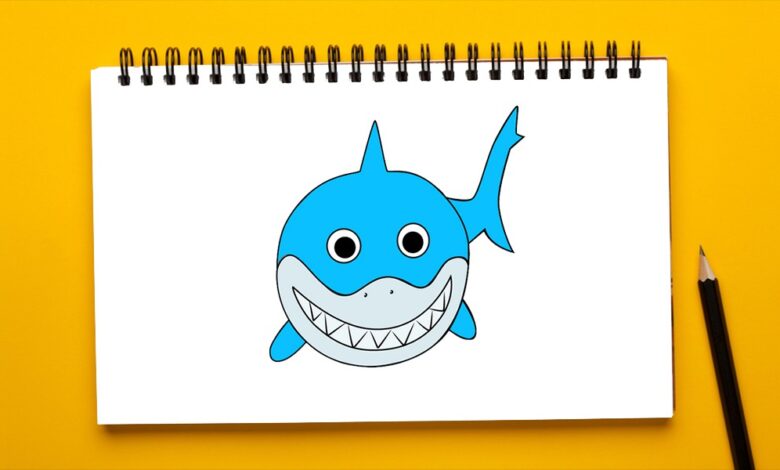Mastering cute:s4nremv56q0= shark drawing: A Creative Journey

Introduction to cute:s4nremv56q0= shark drawing Drawing
Drawing cute:s4nremv56q0= shark drawing can be a delightful and enriching experience, combining the love of the sport with the passion for art. Whether you’re a budding artist, an enthusiastic basketball fan, or someone looking to improve their drawing skills, capturing the dynamic essence of basketball players and the game itself can be incredibly rewarding. This article will guide you through the process of drawing basketball scenes, from basic sketches to detailed compositions.
Basketball drawing cute:s4nremv56q0= shark drawing more than just depicting a ball and a hoop. It requires an understanding of human anatomy, motion, and the game’s unique dynamics. By mastering these elements, you can create compelling and realistic drawings that convey the energy and excitement of basketball.
In this comprehensive guide, we’ll explore various techniques and tips to help you improve your basketball drawing skills. From understanding the fundamentals of drawing to adding intricate details, this article covers everything you need to know to become proficient in drawing basketball scenes.
Understanding the cute:s4nremv56q0= shark drawing
The Importance of Observation

Observation is the cornerstone of any cute:s4nremv56q0= shark drawing drawing. When it comes to basketball, observing live games, watching videos, or studying photographs can provide valuable insights into the players’ movements and the game’s dynamics. Pay attention to the players’ body language, how they dribble, shoot, and defend. Notice the different positions and angles that make each moment unique.
By observing closely, you can capture the cute:s4nremv56q0= shark drawing of the game in your drawings. Focus on the players’ expressions, the way their bodies move, and how they interact with each other and the environment. These details will bring your drawings to life and make them more engaging.
Getting the Proportions Right
Proportions are crucial in any form of drawing, especially when depicting human figures. In basketball drawing, getting the proportions right ensures that your players look realistic and dynamic. Start by sketching basic shapes to outline the body parts. Use circles and ovals for the head, shoulders, and joints, and connect them with lines to form the skeleton of your figure.
Once you have the basic structure, refine cute:s4nremv56q0= shark drawing proportions by adding muscle definition and adjusting the limb lengths. Remember that basketball players often have elongated limbs and athletic builds, so emphasize these features to create a more accurate representation.
Mastering Perspective and Angles
Perspective and angles play a significant role in making your basketball drawings more dynamic and three-dimensional. Experiment with different viewpoints to add depth and interest to your compositions. Whether it’s a bird’s-eye view of the cute:s4nremv56q0= shark drawing or a close-up action shot, varying the perspective can enhance the overall impact of your drawing.
Practice drawing players from different angles to understand how their bodies change with movement and perspective. This skill will help you create more engaging and realistic basketball scenes, capturing the game’s fast-paced nature and the players’ agility.
Drawing the Basketball Player
Sketching the Basic Pose
When drawing a basketball player, start with a basic pose that captures the action you want to depict. Whether it’s a player dribbling, shooting, or cute:s4nremv56q0= shark drawing , the initial sketch sets the foundation for your drawing. Use light, loose lines to outline the figure’s posture and movement. Focus on capturing the player’s balance and weight distribution to create a dynamic pose.
Once you’re satisfied with the basic pose, gradually add more details. Define the player’s limbs, torso, and head, paying attention to the proportions and angles. This stage is crucial for ensuring that your drawing looks realistic and accurately represents the player’s movement.
Adding Muscle Definition and Details
After establishing the basic pose, it’s time to add muscle definition and details. Basketball players have well-defined muscles, especially in their arms and legs. Use reference images to study the muscle groups and how they appear during different movements. This knowledge will help you add realism and depth to your drawing.
Pay attention to the clothing and equipment as well. cute:s4nremv56q0= shark drawing uniforms, shoes, and accessories can add character to your drawing and make it more authentic. Don’t forget to include details like the player’s jersey number, team logo, and any unique features that set them apart.
Capturing Motion and Action
One of the most challenging aspects of drawing basketball players is capturing motion and action. Basketball is a fast-paced game, and players are constantly moving. To convey this sense of motion, use dynamic lines and exaggerated poses. Show the player’s body in mid-action, with limbs extended and muscles tensed.
Use motion lines to indicate the direction and speed of cute:s4nremv56q0= shark drawing . These lines can add energy to your drawing and make it more engaging. Additionally, consider the background and how it interacts with the player. Including elements like a blurred court or other players in action can enhance the sense of motion and create a more immersive scene.
Drawing the Basketball
Understanding the Anatomy of a Basketball
Before drawing a basketball, it’s essential to cute:s4nremv56q0= shark drawingits anatomy. A basketball is a spherical object with a specific pattern of lines and seams. These lines not only add detail but also help indicate the ball’s shape and rotation. Study reference images to familiarize yourself with the basketball’s design and how the lines are distributed.
When drawing the basketball, start with a basic circle to establish its shape. Then, add the lines and seams, paying attention to their curvature and placement. The lines should follow the ball’s contour, giving it a three-dimensional appearance. Adding shading and highlights can further enhance the ball’s realism and make it look more tactile.
Adding Texture and Shading
To make your basketball drawing more realistic, add texture and shading. Basketballs have a textured surface with small bumps, which you can replicate using various shading techniques. Use short, curved lines to create the illusion of texture, following the ball’s contour to maintain its shape.
Shading is crucial for adding depth and cute:s4nremv56q0= shark drawing to your drawing. Determine the light source and use a combination of hatching, cross-hatching, and blending to create shadows and highlights. This technique will give your basketball a three-dimensional look and make it appear more realistic.
Incorporating the Basketball into the Scene
Once you’ve mastered drawing the basketball, it’s time to incorporate it into your scene. Whether the player is dribbling, shooting, or passing, the basketball should interact naturally with the player and the environment. Pay attention to the ball’s position, the player’s grip, and how it moves with the player’s actions.
Use perspective and foreshortening to cute:s4nremv56q0= shark drawing depict the basketball’s position in relation to the player. This skill will help you create more dynamic and realistic scenes, capturing the intensity and excitement of the game.
Drawing the Basketball Court
Creating the Court Layout
The basketball court is an integral part of any basketball drawing. To create a realistic court layout, start with a basic outline of the court’s dimensions. Include the key areas such as the free-throw line, three-point line, and the key. Use reference images or diagrams to ensure accuracy.
Pay attention to the court’s perspective and angles. The court should appear three-dimensional, with lines converging towards a vanishing point. This technique will add depth and realism to your drawing, making it more engaging for the viewer.
Adding Court Details
Once you have the basic layout, add details to make the court more realistic. Include elements like the backboard, hoop, and net. Pay attention to the court markings, such as the lines and circles, which are essential for creating an authentic basketball court.
Consider the court’s surface as well. Adding texture to the floor can make your drawing more realistic. Use shading and highlighting techniques to create the appearance of a polished wood floor or a rough outdoor court. These details will enhance the overall look of your drawing and make it more immersive.
Including Players and Action
To create a complete basketball scene, incorporate players and action into your court drawing. Position the players strategically to depict different aspects of the game, such as a fast break, a defensive stand, or a crucial shot. Use dynamic poses and angles to convey the intensity and excitement of the game.
Pay attention to the interactions between the players and the court. Show how they move, jump, and interact with the environment. This attention to detail will make your drawing more engaging and realistic, capturing the essence of a live basketball game.
Advanced Techniques for Realistic Basketball Drawings
Using Reference Images
Reference images are invaluable tools for improving your basketball drawings. They provide a visual guide to help you understand proportions, anatomy, and movement. Use photographs, videos, and live games as references to study different poses, angles, and actions.
When using reference images, don’t just copy them verbatim. Instead, use them as a guide to enhance your understanding and creativity. Combine elements from different images to create unique compositions and dynamic scenes. This approach will help you develop your style and improve your drawing skills.
Practicing Dynamic Poses
Dynamic poses are essential for creating engaging and realistic basketball drawings. Practice drawing players in various action poses, such as dribbling, shooting, and defending. Use quick, loose sketches to capture the essence of the movement and refine the details later.
Experiment with different angles and perspectives to add variety to your drawings. Try drawing players from unusual viewpoints, such as from above or below, to create more interesting compositions. This practice will help you improve your ability to capture motion and action in your drawings.
Experimenting with Lighting and Shadows
Lighting and shadows play a crucial role in creating depth and realism in your basketball drawings. Experiment with different light sources and shadow placements to see how they affect the overall composition. Use shading techniques to create contrast and highlight the players and the environment.
Consider the direction and intensity of the light. Harsh lighting can create dramatic shadows and add intensity to the scene, while soft lighting can create a more subtle and realistic effect. Use these techniques to enhance the mood and atmosphere of your drawing.
Developing Your Style
Finding Inspiration
Finding inspiration is essential for developing your unique style. Look at the works of other artists, watch basketball games, and study photographs to get ideas and inspiration. Analyze different styles and techniques to see what resonates with you.





